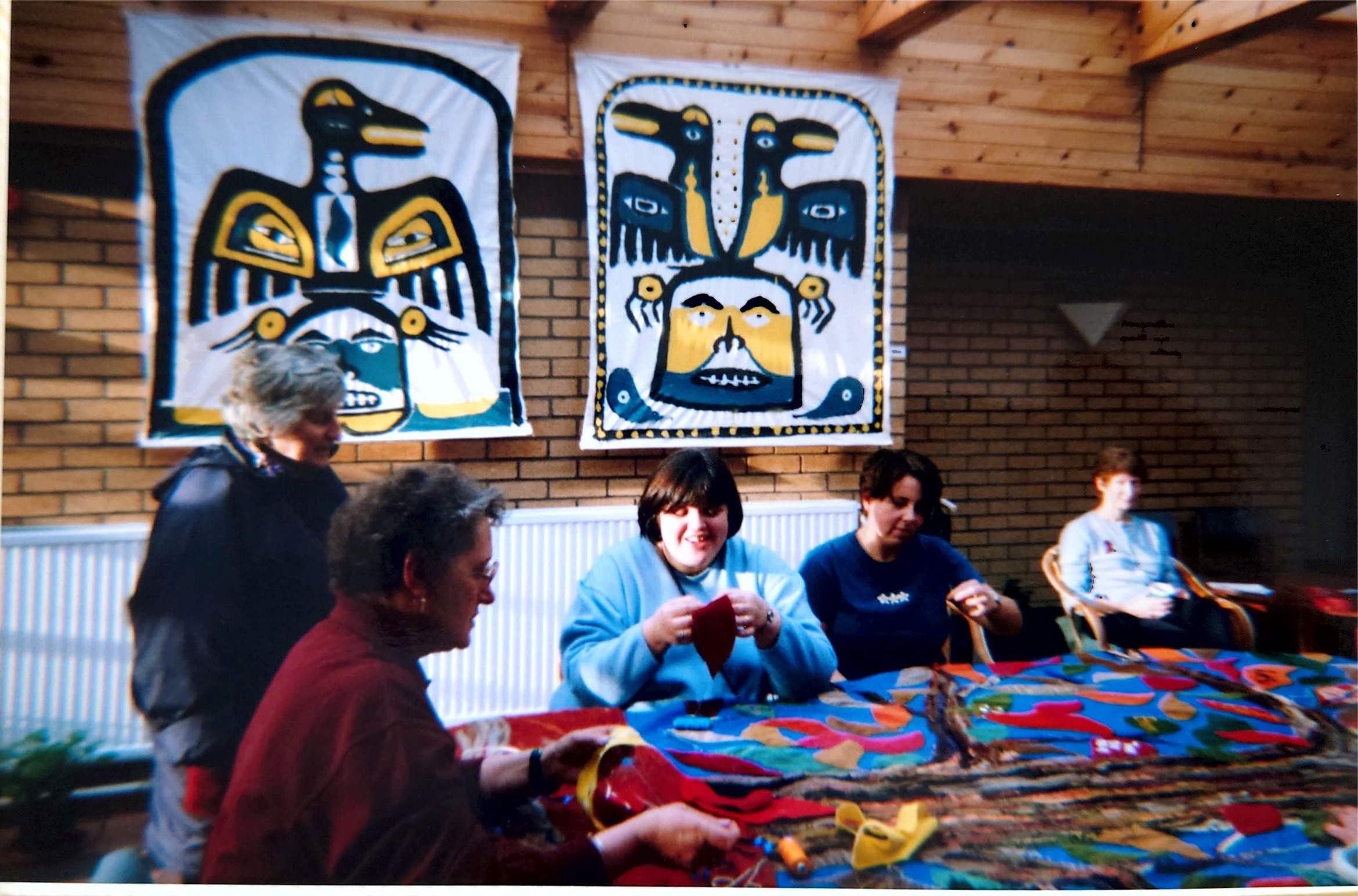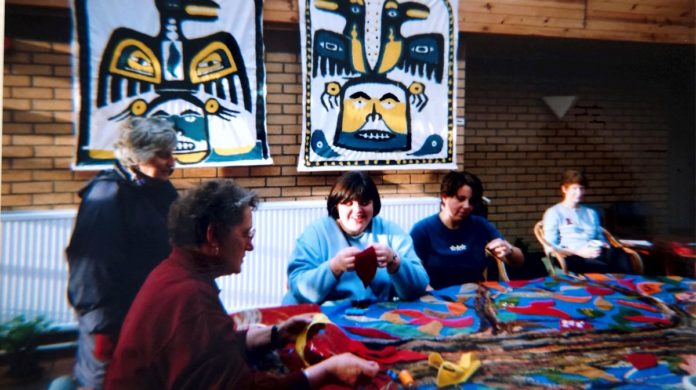
Barton Friedland hadn’t seen a picture of his friend Rusty Uram since his death in 1991. They were dancers together at New York’s Pyramid Bar, home at the time to nightlife staples including RuPaul and Lady Bunny. Twenty years after Rusty died, aged 25, Barton was shocked to open up Instagram and see his friend again.
In the post, Rusty’s image stares up at you from a series of black and white test shots. Some are partially hidden, but of those visible, the lens has captured a handsome young man with a buzzcut, smouldering for the camera. The caption tells us that Rusty used to introduce himself as “an unapologetic fag”, and that he would wave and blow kisses to crowds of homophobic protesters at Pride marches.
The image brought back Barton’s own memories of his friend, and the impact that his death had on him. “Rusty was light and funny and made me, a serious person, laugh,” Barton tells me. “He went so fast, and it really impacted me because it didn’t feel fair.”
Rusty’s story is one of many that comprise The AIDS Memorial Instagram page, dedicated to publishing intimate accounts of those lost to AIDS written by those close to them. Although Rusty died in 1991, his memory is kept alive by this new eulogy written by a friend after 20 years – a tribute to a life taken far too young, by a disease that was indiscriminate in who it killed.
The AIDS Memorial account is doubtless familiar to many LGBTQ+ Instagram users; it has over 200,000 followers and acts as a hugely important modern tool for people seeking to look back and remember those lost to the last global pandemic. It is, however, a relatively new phenomenon. For those of us lucky enough to have been too young to witness the worst of the crisis, it can be difficult to comprehend the level of dedication it took to memorialise those lives lost to AIDS before the onset of the digital age.
But long before the AIDS Memorial Instagram page, came the NAMES Project AIDS Memorial Quilt – a huge communal art project in which friends, lovers, and families of those who had died of AIDS were invited to make panels memorialising their loved ones, which were then compiled and sewn into a larger quilt. Rusty Uram has a panel on the quilt, and his is just one of thousands which could be made by anyone, for anyone. The project was started in the US in 1985 and is now the largest community art project in the world, with the quilt itself weighing over 54 tonnes.
The UK arm of the quilt is smaller than its US counterpart, but no less significant in its historical and cultural importance. There is little documentation about how the project made its way to the UK, but it’s likely that information about the various displays in the US made travelled across the pond through the gay press and word of mouth.
Many of the charities involved in the preservation of the quilt credit Alistair Hume with galvanising communities wracked by grief into creating the earliest panels for a wider quilt project in the UK. Hume was a figure in Edinburgh’s gay scene, running a bar named Key West, and was seemingly inspired by viewing the US quilt on display in San Francisco in the late 80s, deciding to launch a similar project in the UK upon returning to Scotland.
The UK AIDS Memorial Quilt was exhibited at Acorn House in King’s Cross this summer, marking the first time it had been displayed in full since 1994. Seeing the quilt in person, it’s hard not to be floored by its sheer magnitude – both physical and emotional. It’s difficult to explain the impact of seeing hundreds of 12 foot by 12 foot panels placed carefully over four stories of a central London office block, each one intricately hand-crafted in honour and defiant celebration of a life lost to the AIDS epidemic in the 1980s and 90s.
There are panels for mothers, fathers, sons, sisters, brothers, daughters, friends, husbands, lovers, exes, colleagues, tribute panels to public figures that include author Bruce Chatwin, photographer Robert Mapplethorpe, director Derek Jarman, activist Mark Ashton, and actors Denholm Elliott and Ian Charleson. There are multiple panels dedicated to Freddie Mercury. Media portrayals of the AIDS epidemic often centre their stories around the experiences of gay men, and whilst AIDS was a disease that ravaged the queer community, the quilt shows us that those who died were not a monolith.
It’s clear that the quilt was borne from a need for people to find a physical outlet for their grief amidst the fear, ignorance and media-fuelled hysteria that dominated the discourse around AIDS in the late 80s and early 90s. More than that, it is a chance to celebrate, as Barton puts it, “the lived experience of that person and the impact that those people had on other people’s lives”.
When Harry Hillery made a panel for his friend Andrea in 1992, he never expected to see it again, believing it to have been flown for a display in Washington DC in the 90s. So, when he arrived at Acorn House in July, he was overjoyed to see the panel he’d created almost 30 years earlier. “I was elated by it,” he recounts, “I was getting really upset on the train to London, preparing myself. Rather than feeling torn apart by it, it was a beautiful, lifting experience.”
For Harry, the quilt’s impact lies in its preservative power, in being able to see his friend’s name and tell his story decades later. “The other thing I loved about seeing the quilt was being able to tell the people [at the display] his story,” he adds. “If you say a name a lot, it keeps a life in it. He had gone from being Andrea the florist who wore Vivienne Westwood and was the life and soul of the party, to being Andrea who died of AIDS. Andrea’s became a name linked to AIDS and that’s all that was left. He was so much more than that.”
For Barton Friedland, displaying the quilt was about showing an alternative to the dominant death-focused media narrative around AIDS. “The quilt as a medium expresses the value of life,” he says. “It disrupts the narrative by confronting the viewer with the humanity of that person. Even though this person is dead, we cannot deny the impact that this person has had on the person’s life who has made the quilt. That is an irrevocable fact.”
Barton was instrumental to the organisation of Quilts of Love – a 1994 display at Hyde Park. Similarly to Hume, he was inspired to get involved with the quilt upon seeing an earlier display in Washington DC in 1992. He was struck by the “scale and intimacy” of the quilt, deciding to use the influence he had to create a similar experience in London. Barton’s partner at the time was Rifat Özbek, the fashion designer who had just won British Designer of the year for the second time. “The NAMES project in the UK at the time was quite small. The idea was that we could garner people’s attention by drawing them in using designers,” Friedland explains.
The core group involved in the quilt’s organisation managed to display panels from designers and fashion houses including Vivienne Westwood, Pam Hogg and Dolce & Gabbana. Barton also managed to contact Princess Diana about the display, and whilst she was indisposed on the day it took place, she wrote a letter of support, which allowed for Barton and his team to access a far greater amount of funding than they would have otherwise.
The funding not only helped to display the quilt, but to provide funding for vital services for those living with HIV in London through organisations including Crusaid’s Hardship Fund, The Food Chain, and the Immune Development Trust. The fact that the quilt was able to be displayed on such a scale is a testament to the power of celebrity, but the fact that it has taken almost 20 years for another display to take place is a damning indictment of a lack of funding available for queer projects.
Francis Osis, a medical historian currently working as the community heritage officer at Scottish HIV charity Waverley Care, emphasises the importance of the quilt as a historical artefact. It gives an insight into the lived experience of people living through the early stages of the pandemic in a way that medical records cannot. “It’s a relatively common issue when it comes to medical archiving,” he tells me. “Patient voices are missing from archives in general, which skews the history of medicine.”
The quilt works to offset this, emphasising the lived experiences of those who died victims of a negligent public health policy. If we were just basing our knowledge of HIV and AIDS on medical records, we would have no record of community, family or friendships. For Francis, part of the task in memorialising those lost to AIDS is “capturing the joy in the community that people built and the experiences that they had together”.
Despite its clear cultural and historical significance, the quilt still doesn’t have a permanent home. Its size means that logistically, storing and taking care of it is a difficulty. The panels are currently in the care of Positive East, a London-based HIV charity, but they are stored in calico bags. Many of the panels are at real risk of deteriorating, and there has been no funding secured for their proper care and restoration.
Siobhan Lanigan is CEO of The Food Chain, a charity involved in preserving the quilt. For her, finding a permanent home for the quilt is of paramount importance. She feels it loses its power if it isn’t displayed. “It’s a social memorial; it can’t sit in an archive,” she says. “It needs to be displayed and interacted with.”
This December marks 40 years since the first recorded UK death from the disease we now know as AIDS, and yet the UK still has no permanent memorial to those who have died. There are obvious parallels between that period and the public health crisis we currently find ourselves living through; an inert government incapable of successful health policy being just one. The quilt is an excellent example of the value of memorialising those lost to a public health crisis whilst we are still living through one, and a reminder of the stigma faced by so many.
It is clear from speaking to anyone involved in the making or the preservation of panels that creating the quilt wasn’t just an act of mourning, but a protest too. One of the most striking panels is one that has been covered up with a white sheet, adorned with a red ribbon and a short message that reads;
“This panel was made by a friend for a friend.
The parents do not want this panel shown anywhere.
The stigma still exists – until this changes this panel will remain covered.
A red ribbon is not enough. The Quilt is not enough.
What will it take?
Attitudes must change”
On the sunny day that I went to visit the quilts, the light was shining just enough to see the outlines of the intricate and beautiful panel underneath. For Siobhan, one goal for the future is to be able to remove the cover.
“The Quilt Partnership would love to be able to reveal the original panel and show the name of the person commemorated, but the stigma surrounding HIV is far from over,” she says. “So all we can do is continue the work to make sure that one day it is gone and everyone can be named and celebrated.”








